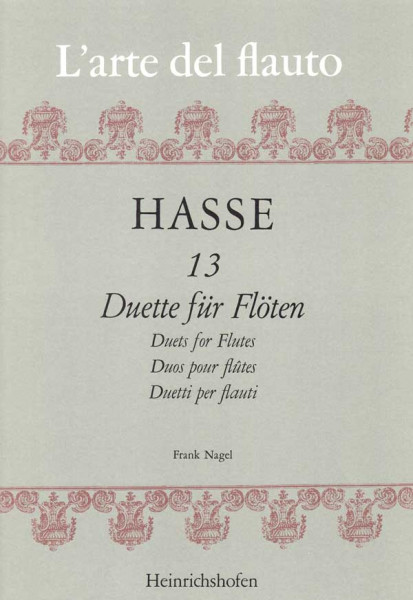No results were found for the filter!
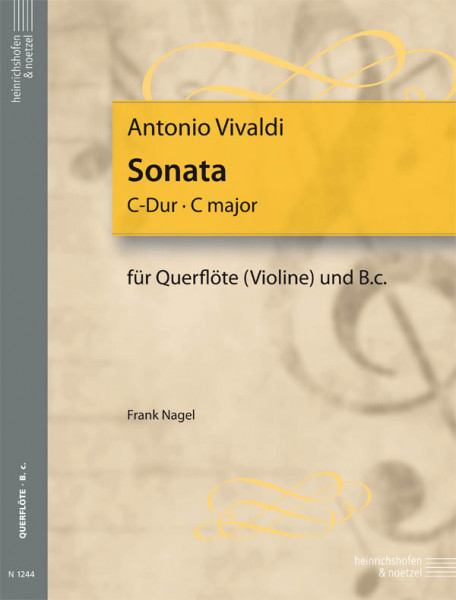
Antonio Vivaldi
Sonata C major Flute (violin) and basso continuo (violoncello ad. lib.)
Content: -Affettuoso -Allegro -Larghetto -Allegro
Mehr €12.00 *
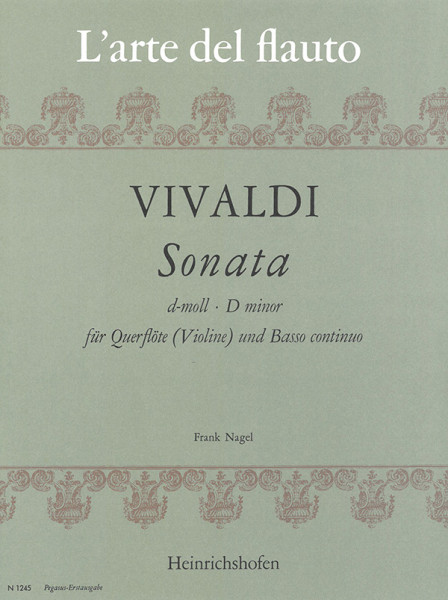
Antonio Vivaldi
Sonata D minor Flute (violin) and basso continuo (violoncello ad.lib.)
€12.00 *
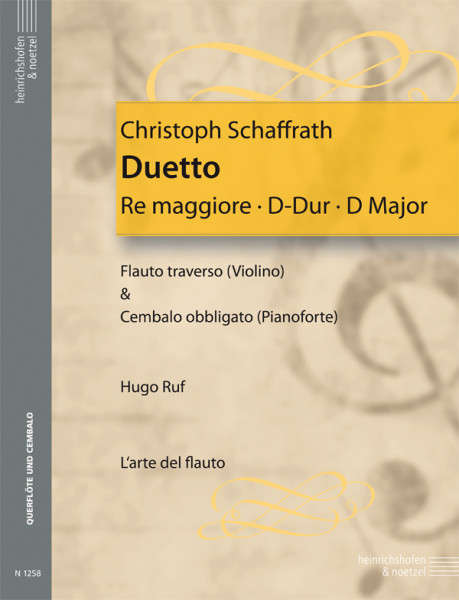
Christoph Schaffrath
Duetto D major | op. 1 Flute (violin) and hapsichord (piano)
Christoph Schaffrath (1709-1763) was one of the important musicians and composers that the music-loving Frederick II of Prussia gathered around him. He can be described as one of the most interesting and imaginative composers of the Berlin circle. In addition to overtures, symphonies and quartets, he mainly wrote harpsichord works and chamber music in which the keyboard instrument plays a leading role.Schaffrath's Duet in D major is published here for the first time in a new edition. Our edition is based on the copy of the first print of the ‘ Six Duets op. 1 ’ in the Saxon State Library in Dresden. Duets I, III and V are written for violin and harpsichord, the others for flute and harpsichord. The present composition is Duetto II. The editor's work extends to compiling the score, correcting some errors and setting out the continuo passages. Additions to the score are indicated as such by small lines, brackets or dashes. Content: -Allegro -Andante -Allegro
Mehr €14.00 *
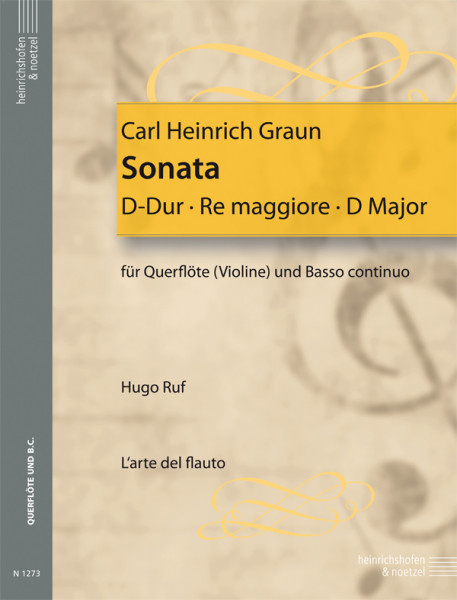
Carl Heinrich Graun
Sonata D Major Flute (violin) and basso continuo (violincello ad.lib.)
The publication of this sonata by the Potsdam court conductor Carl Heinrich Graun is based on a manuscript in the possession of the Saxon State Library in Dresden. Our edition is the first time the work has appeared in print. Editorial additions are marked as such in the score; added slurs are dotted, added ornaments and dynamic markings are bracketed. The harpsichord accompaniment, written after the figured bass, is printed in small print. Content: - Largo - Poco allegro - Vivace
Mehr €13.00 *
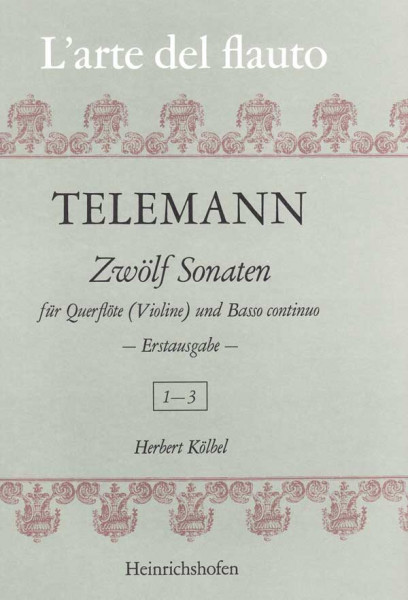
Georg Philipp Telemann
Twelve sonatas | sonatas 1 - 3 | volume 1 Flute (violin) and Basso continuo
First edition This edition is based on a manuscript from the Staatsbibliothek Berlin, Preußischer Kulturbesitz, Musikabteilung. It comes from the estate of Telemann, who gave it to his grandson Georg Michael Telemann (1748-1831). G. Poelchau acquired the manuscript in 1834 with a pack of music stored in a church tower in Riga. From Poelchau's estate († 1836) the sonata work came to the Royal Library in Berlin. The sonatas are dedicated to the brothers Rudolf, Hieronymus and Johannes Wilhelm Burmester of a Hamburg patrician family dated 1 March 1734, with the note that they follow the ‘12 methodical sonatas’, which were also dedicated to the first two brothers. The close connection between the two large sonata works can be found in their valuable musical content, in the sequence of movements (slow, fast, slow, fast), and in the succession of keys (C-a-D-h-E-F-d-G-e-A-f sharp-g). The bass lines are often involved in the theme. Occasionally we are reminded of J.S. Bach's inventions. In the title, the violin is named as the solo instrument before the flute, as several sonatas are unmistakably written “violinistically” without this hindering their playability for flute. The present edition adheres strictly to the manuscript. Suggestions for dynamics are indicated as such by brackets, as are those for articulation (by dotted lines), which may differ for violinists from those intended for flute. Experienced players should use the original figured bass for their own interpretation. The 12 sonatas made available to the public here for the first time are among the best compositions of this kind by Telemann, who dedicated them to 'connoisseurs and lovers' with the wish '...faire une bonne partie de Vos amusements'. The sonatas will fulfill this purpose today just as they did at that time.
Mehr €27.50 *
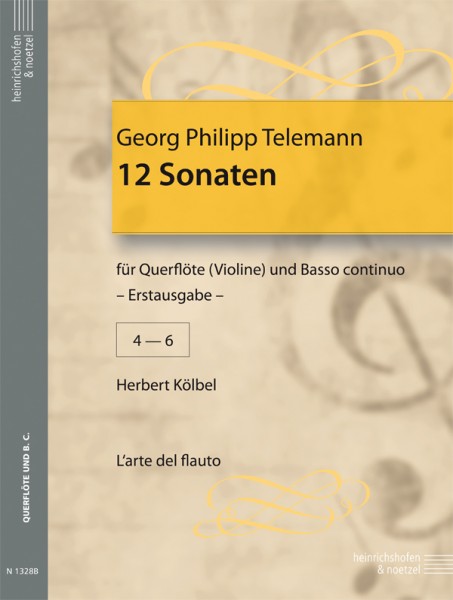
Georg Philipp Telemann
Twelve sonatas | sonatas 4 - 6 | volume 2 Flute (violin) and basso continuo
First edition This edition is based on a manuscript from the Staatsbibliothek Berlin, Preußischer Kulturbesitz, Musikabteilung. It comes from the estate of Telemann, who gave it to his grandson Georg Michael Telemann (1748-1831). G. Poelchau acquired the manuscript in 1834 with a pack of music stored in a church tower in Riga. From Poelchau's estate († 1836) the sonata work came to the Royal Library in Berlin. The sonatas are dedicated to the brothers Rudolf, Hieronymus and Johannes Wilhelm Burmester of a Hamburg patrician family dated 1 March 1734, with the note that they follow the ‘12 methodical sonatas’, which were also dedicated to the first two brothers. The close connection between the two large sonata works can be found in their valuable musical content, in the sequence of movements (slow, fast, slow, fast), and in the succession of keys (C-a-D-h-E-F-d-G-e-A-f sharp-g). The bass lines are often involved in the theme. Occasionally we are reminded of J.S. Bach's inventions. In the title, the violin is named as the solo instrument before the flute, as several sonatas are unmistakably written “violinistically” without this hindering their playability for flute. The present edition adheres strictly to the manuscript. Suggestions for dynamics are indicated as such by brackets, as are those for articulation (by dotted lines), which may differ for violinists from those intended for flute. Experienced players should use the original figured bass for their own interpretation. The 12 sonatas made available to the public here for the first time are among the best compositions of this kind by Telemann, who dedicated them to ' connoisseurs and lovers' with the wish '. ..faire une bonne partie de Vos amusements' . The sonatas will fulfill this purpose today just as they did at that time.
Mehr €27.50 *
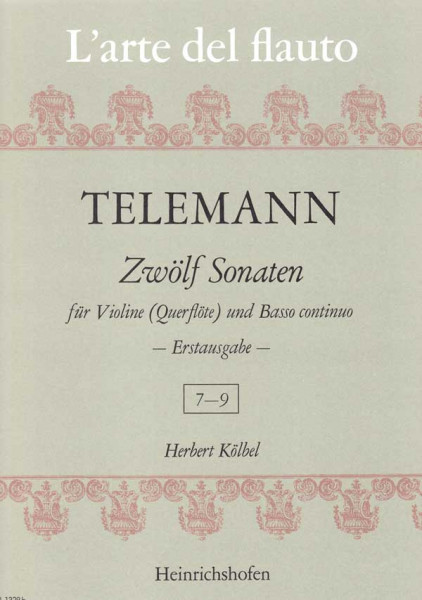
Georg Philipp Telemann
Twelve sonatas | sonatas 7 - 9 | volume 3 Flute (violin) and basso continuo
First edition This edition is based on a manuscript from the Staatsbibliothek Berlin, Preußischer Kulturbesitz, Musikabteilung. It comes from the estate of Telemann, who gave it to his grandson Georg Michael Telemann (1748-1831). G. Poelchau acquired the manuscript in 1834 with a pack of music stored in a church tower in Riga. From Poelchau's estate († 1836) the sonata work came to the Royal Library in Berlin. The sonatas are dedicated to the brothers Rudolf, Hieronymus and Johannes Wilhelm Burmester of a Hamburg patrician family dated 1 March 1734, with the note that they follow the ‘12 methodical sonatas’, which were also dedicated to the first two brothers. The close connection between the two large sonata works can be found in their valuable musical content, in the sequence of movements (slow, fast, slow, fast), and in the succession of keys (C-a-D-h-E-F-d-G-e-A-f sharp-g). The bass lines are often involved in the theme. Occasionally we are reminded of J.S. Bach's inventions. In the title, the violin is named as the solo instrument before the flute, as several sonatas are unmistakably written “violinistically” without this hindering their playability for flute. The present edition adheres strictly to the manuscript. Suggestions for dynamics are indicated as such by brackets, as are those for articulation (by dotted lines), which may differ for violinists from those intended for flute. Experienced players should use the original figured bass for their own interpretation. The 12 sonatas made available to the public here for the first time are among the best compositions of this kind by Telemann, who dedicated them to 'connoisseurs and lovers' with the wish '...faire une bonne partie de Vos amusements'. The sonatas will fulfill this purpose today just as they did at that time.
Mehr €27.50 *
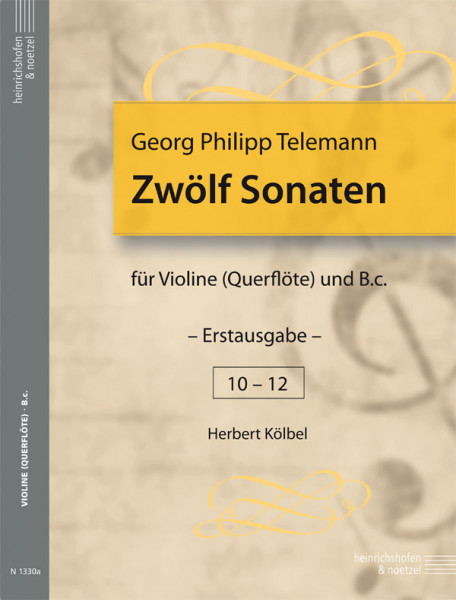
Georg Philipp Telemann
Twelve Sonatas | sonatas 10 - 12 | volume 4 Violin (flute) and Basso continuo
First edition This edition is based on a manuscript from the Staatsbibliothek Berlin, Preußischer Kulturbesitz, Musikabteilung. It comes from the estate of Telemann, who gave it to his grandson Georg Michael Telemann (1748-1831). G. Poelchau acquired the manuscript in 1834 with a pack of music stored in a church tower in Riga. From Poelchau's estate († 1836) the sonata work came to the Royal Library in Berlin. The sonatas are dedicated to the brothers Rudolf, Hieronymus and Johannes Wilhelm Burmester of a Hamburg patrician family dated 1 March 1734, with the note that they follow the ‘12 methodical sonatas’, which were also dedicated to the first two brothers. The close connection between the two large sonata works can be found in their valuable musical content, in the sequence of movements (slow, fast, slow, fast), and in the succession of keys (C-a-D-h-E-F-d-G-e-A-f sharp-g). The bass lines are often involved in the theme. Occasionally we are reminded of J.S. Bach's inventions. In the title, the violin is named as the solo instrument before the flute, as several sonatas are unmistakably written “violinistically” without this hindering their playability for flute. The present edition adheres strictly to the manuscript. Suggestions for dynamics are indicated as such by brackets, as are those for articulation (by dotted lines), which may differ for violinists from those intended for flute. Experienced players should use the original figured bass for their own interpretation. The 12 sonatas made available to the public here for the first time are among the best compositions of this kind by Telemann, who dedicated them to 'connoisseurs and lovers' with the wish '...faire une bonne partie de Vos amusements'. The sonatas will fulfill this purpose today just as they did at that time. Content: X. - Soave - Dolce - Spirituoso XI. - Dolente - Vivace - Piacevole XII. - Teneramente - Spirituoso - Gratioso
Mehr €27.50 *
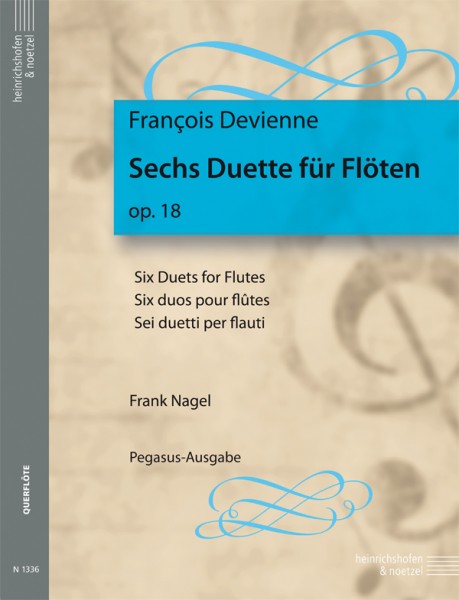
François Devienne
Six duets 2 flutes
Content: I. Op. 18 Nr. 1 - Allegro - Rondo / Allegretto - Mineur II. Op. 18 Nr. 2 - Allegro - Minuetto I - Minuetto II - Minuetto I III. Op. 18 Nr. 3 - Adagio - Allegro IV. Op. 18 Nr. 4 - Allegro - Minuetto I - Minuetto II V. Op. 18 Nr. 5 - Allegro - Grazioso con Variatione VI. Op. 18 Nr. 6 - Allegro - Rondo / Allegretto
Mehr €13.50 *

Johann Joachim Quantz
Six duets op. 5 | volume 1 2 flutes
Johann Joachim Quantz (1697-1773) was a German composer and flautist. Orphaned at an early age, he was apprenticed to a related town musician in Merseburg. He then studied counterpoint with Zelenka and Fuchs in Vienna in 1717. He joined the Royal Polish Chapel in Dresden and Warsaw in 1718, first as an oboist and then as a flautist. From 1724-1727, he travelled to Italy, Paris and London on an electoral scholarship. Returning to his old position in Dresden, he played for Crown Prince Frederick of Prussia in 1728, who chose him as his teacher and appointed him as his musical confidant in Berlin after his accession to the throne in 1741. Quantz wrote the first German flute school ‘Versuch einer Anweisung die Flöte traversiere zu spielen’, which was authoritative until the 19th century and is particularly valuable to us today as a source for the performance practice of early music. Among other things, he composed flute concertos, chamber music with flute, solo and trio sonatas for flute and basso continuo, flute duets and trios.
Mehr €9.90 *
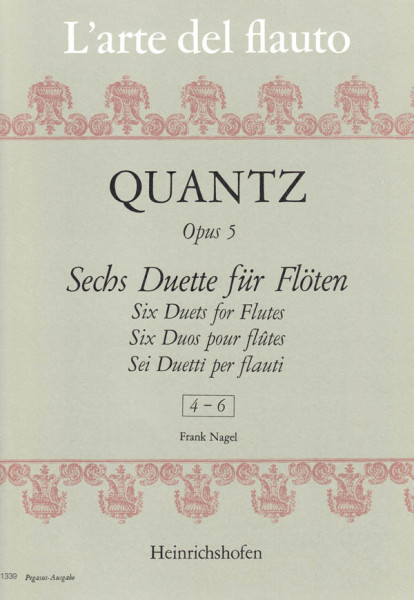
Johann Joachim Quantz
Six duets op. 5 | volume 2 2 flutes
Johann Joachim Quantz (1697-1773) was a German composer and flautist. Orphaned at an early age, he was apprenticed to a related town musician in Merseburg. He then studied counterpoint with Zelenka and Fuchs in Vienna in 1717. He joined the Royal Polish Chapel in Dresden and Warsaw in 1718, first as an oboist and then as a flautist. From 1724-1727, he travelled to Italy, Paris and London on an electoral scholarship. Returning to his old position in Dresden, he played for Crown Prince Frederick of Prussia in 1728, who chose him as his teacher and appointed him as his musical confidant in Berlin after his accession to the throne in 1741. Quantz wrote the first German flute school ‘Versuch einer Anweisung die Flöte traversiere zu spielen’, which was authoritative until the 19th century and is particularly valuable to us today as a source for the performance practice of early music. Among other things, he composed flute concertos, chamber music with flute, solo and trio sonatas for flute and basso continuo, flute duets and trios.
Mehr €9.00 *
Viewed


